Best inkjet printer in UK
Here are the best buys on the market right now
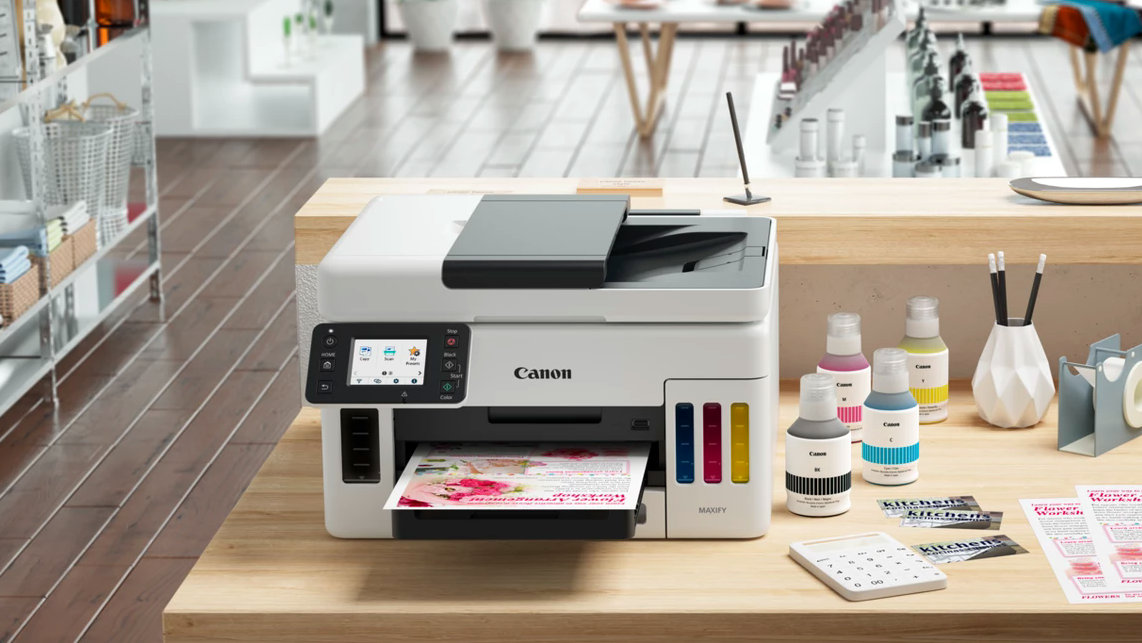
Even in a digital world, we still need a printer for studies, home working, or to make business run. But what is the best inkjet printer around right now? There are plenty of models to choose from - and the key is to pick the one that meets all of your needs, and is within your budget.
I have tested hundreds of printers over the years, and below are some of my top recommendations for inkjet printers that are on sale right now in the UK…
The best inkjet printers in 2023


1: Canon MAXIFY GX6050
Specifications
Reasons to buy
Reasons to avoid
Speedy and versatile, this printer is ever-helpful and very easy to live with. It’s ideally suited to busy individuals, families and anyone who has a lot of printing on their hands. Full bottles of ink will see you through 6,000 mono pages and 14,000 color pages, stretching to 9,000 and 21,000 in Economy mode. Printing itself is super-quick at 24ipm (impressions per minute) mono and 15.5ipm for color. Copying and scanning tasks are simplified by a 50-sheet ADF, functions being brought together by a 2.7-inch color touchscreen with an intuitive interface. Nice touches include an additional rear paper input tray for specialist media and 1.2m banner printing. The full set of pigment-based inks gives very robust mono and color output but is less well suited to photo printing on glossy paper.
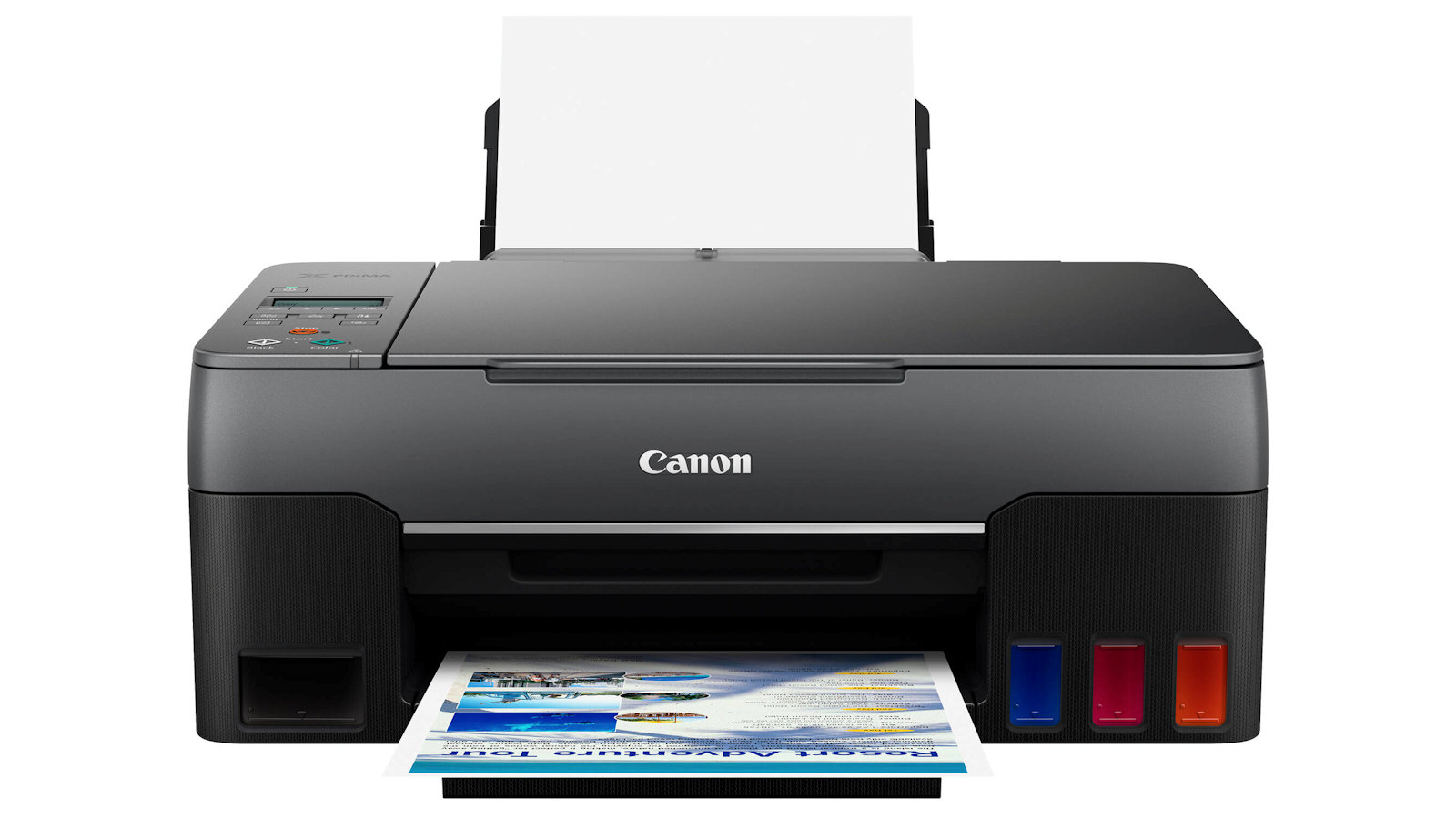
2: Canon PIXMA G3560 MegaTank
Specifications
Reasons to buy
Reasons to avoid
Despite having an initial purchase price that’s only about the same as for some conventional cartridge-based printers, this Canon gives you a very affordable route into tank-based printing. Even so, its set of ink bottles is good for 6,000 mono pages and 7,700 in color. With a pigment-based black ink and dye-based cyan, magenta and yellow, it delivers robust mono text and makes a good stab at photo printing on glossy paper, delivering around 2,200 6x4-inch color photos from full tanks. There’s no color touchscreen but controls are nevertheless intuitive, based on a 2-line mono LCD. 1.2m banner printing is also supported but duplex printing needs to be done manually and it’s not particularly fast.
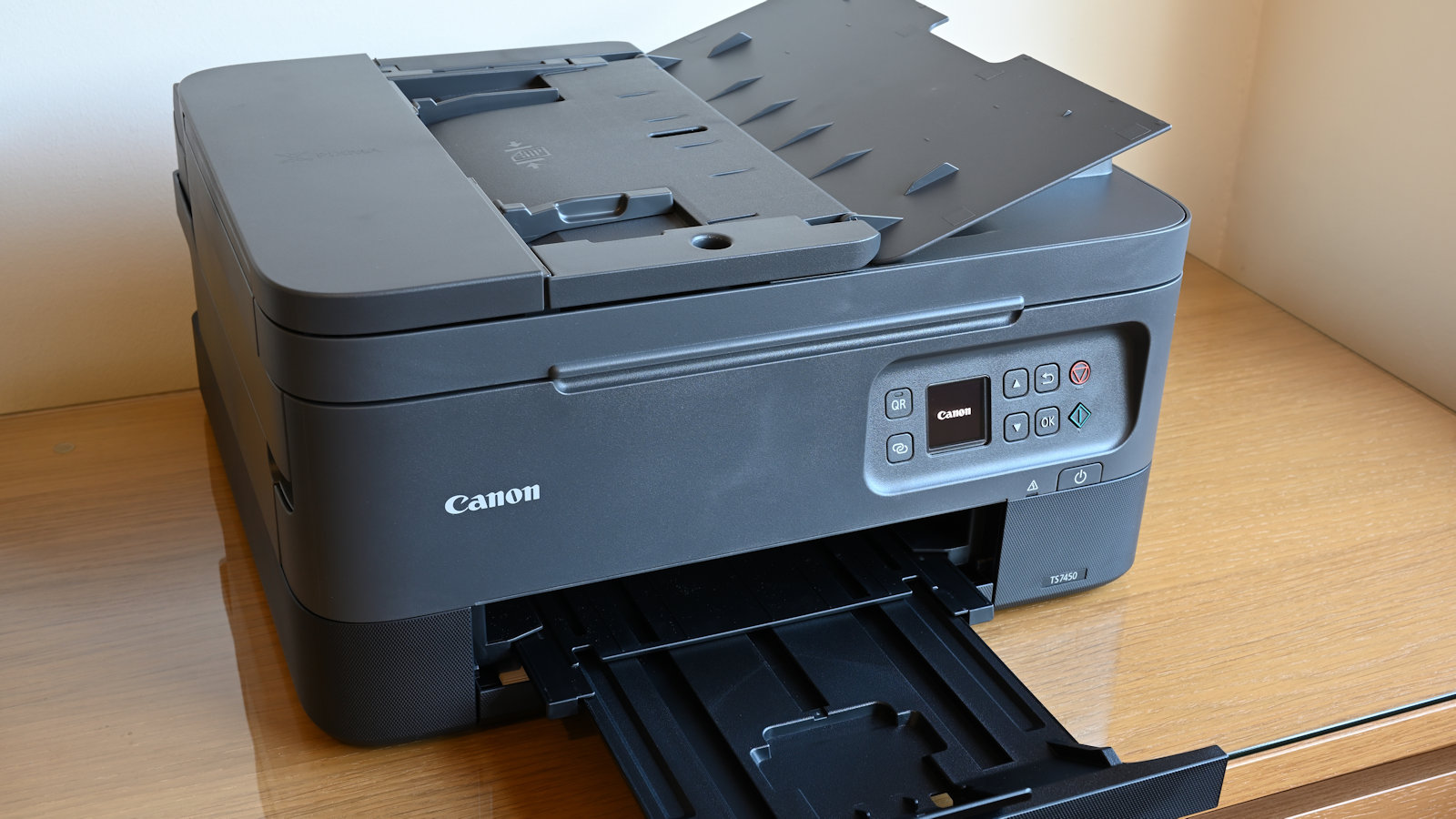
3: Canon PIXMA TS7450i
Specifications
Reasons to buy
Reasons to avoid
Most printers aren’t just for printing these days. They’re also for scanning and photocopying. This low-budget, cartridge-based printer is well up to multi-function tasks, featuring a scanner that comes complete with a 35-sheet auto document feeder and automatic duplex (double-sided) printing. It doesn’t have individual cartridges for all four colors, instead running on a pigment-based black cartridge and dye-based tri-color cartridge. There are upsides though, in that ordering and replacing cartridges are easier, and you effectively get a brand new print head with each cartridge. High-yield ‘XL’ cartridges are available to reduce printing costs. Print speeds are quick and print quality is very good for mono and color documents, and pretty reasonable for color photo output.
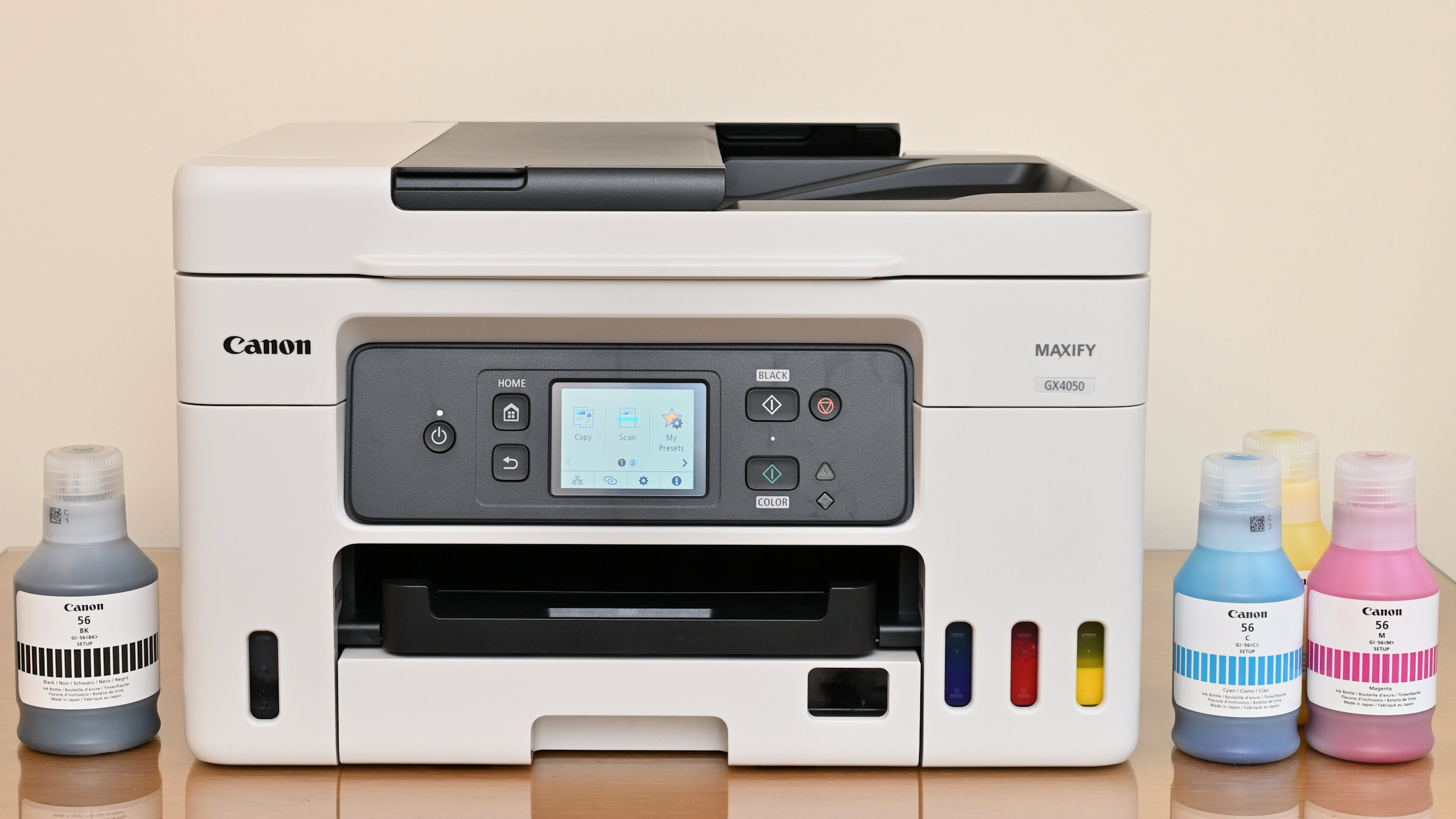
Specifications
Reasons to buy
Reasons to avoid
Like a number of other Canon MAXIFY printers, this one runs on four pigment-based CMYK inks, with bottles rated at 6,000/14,000 mono and color pages, stretching to 9,000/21,000 in economy mode. An upside of the all-pigment inks is that you get robust prints for both mono and color documents on plain paper, which are resistant to smudging from water and highlighter pens. The downside is that photo quality on glossy paper is comparatively poor. Home office-friendly features include a 35-sheet ADF which feeds a scanner for scanning and copying, as well as direct fax. Controls are intuitive, based on a 2.7-inch color touchscreen. There’s an internal 250-sheet paper cassette, plus a 100-sheet rear feeder for photo paper and other specialist media.
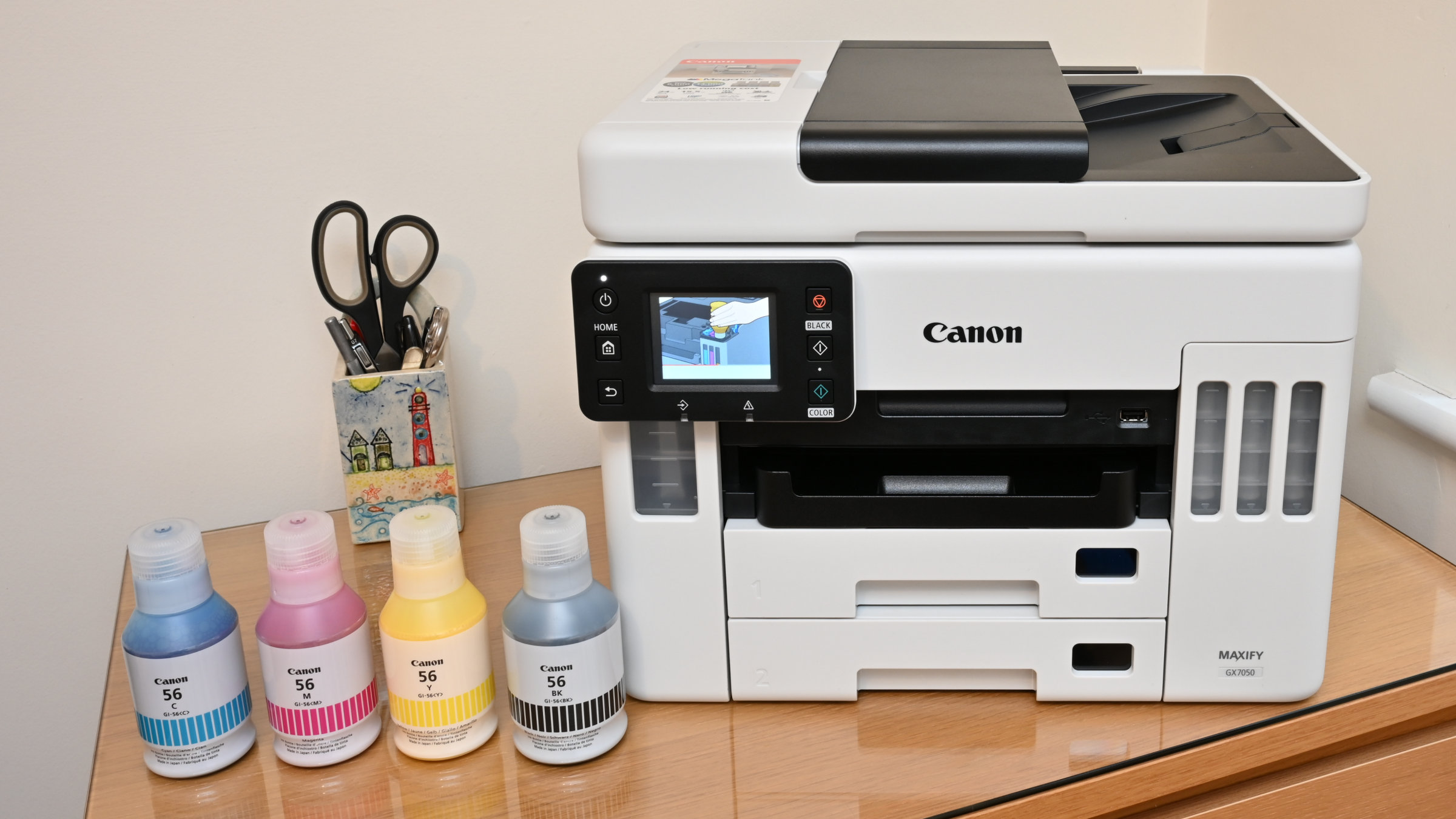
Specifications
Reasons to buy
Reasons to avoid
A very business-oriented printer, this one builds on the core features of the Canon MAXIFY GX6021/GX6050/GX6060. It has all the same benefits of super-fast print speeds, great stamina with up to 6,000 mono pages and 14,000 color pages per set of bottles (9,000 and 21,000 in Economy mode), auto duplex printing, a color tilting touchscreen interface and 1.2m banner printing. On top of this it adds a secondary paper input cassette, so you get two 250-sheet cassettes plus the same additional 100-sheet rear tray. Scanning and copying for double-sided pages is much quicker, thanks to both sides each page being scanned in a single pass, and the printer also adds a direct fax facility.
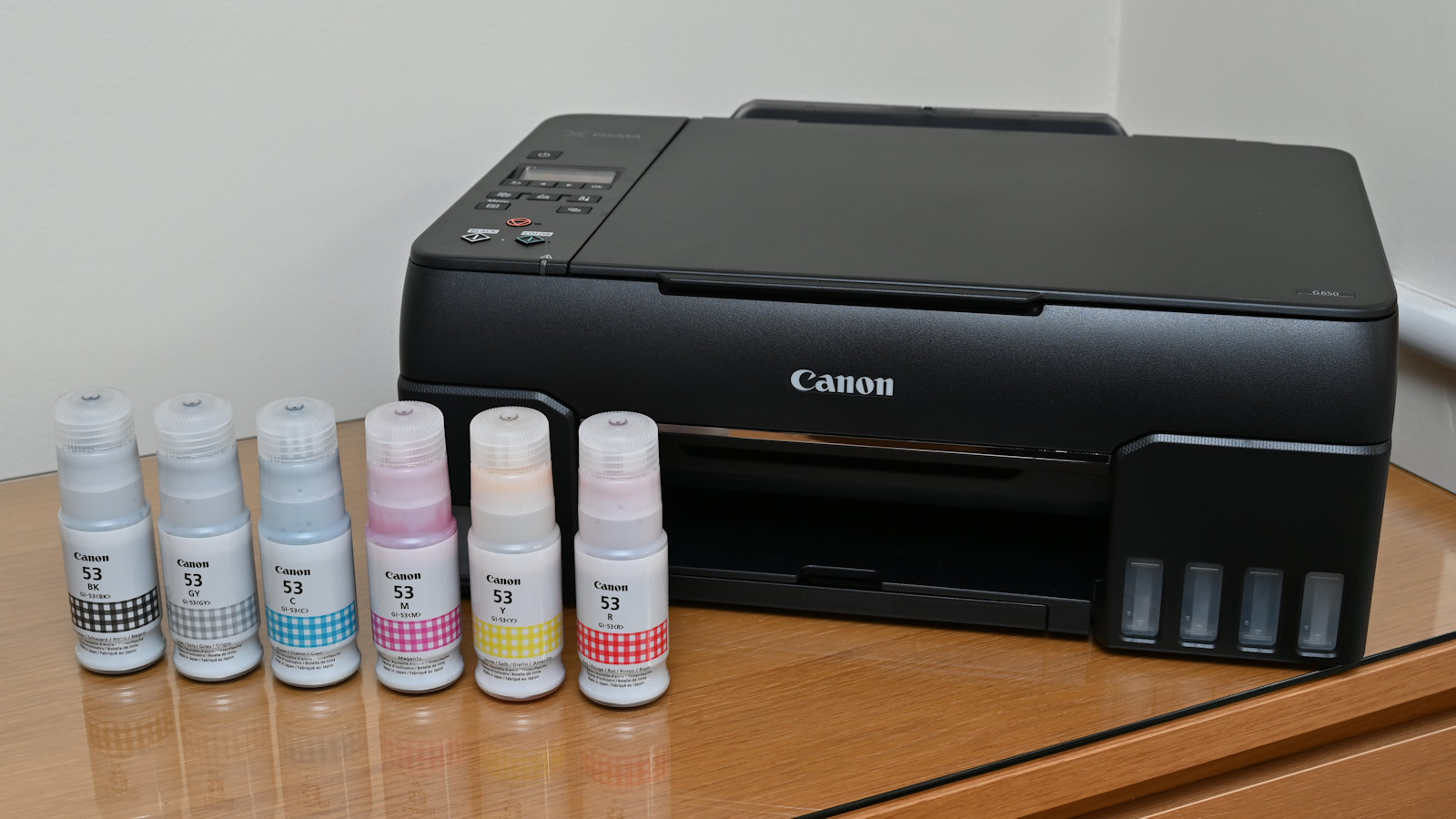
Specifications
Reasons to buy
Reasons to avoid
Less ideal for document printing, this is more of a specialist photo printer, featuring six dye based inks. As well as the usual CMYK, you also get red and gray inks, which extend the gamut for color photo printing and increase the tonal range and definition for black & white photo prints. There’s no internal paper feed cassette, so paper is only inputted from an upright rear tray, but the printer features a high-resolution 1200dpi scanner, ideal for copying existing photo prints. A set of ink bottles is good for 3,800 color 6x4-inch photo prints but print speeds are pretty pedestrian. Mono and color documents are printed at 3.9ipm, and a borderless 6x4-inch photo takes about 47 seconds.
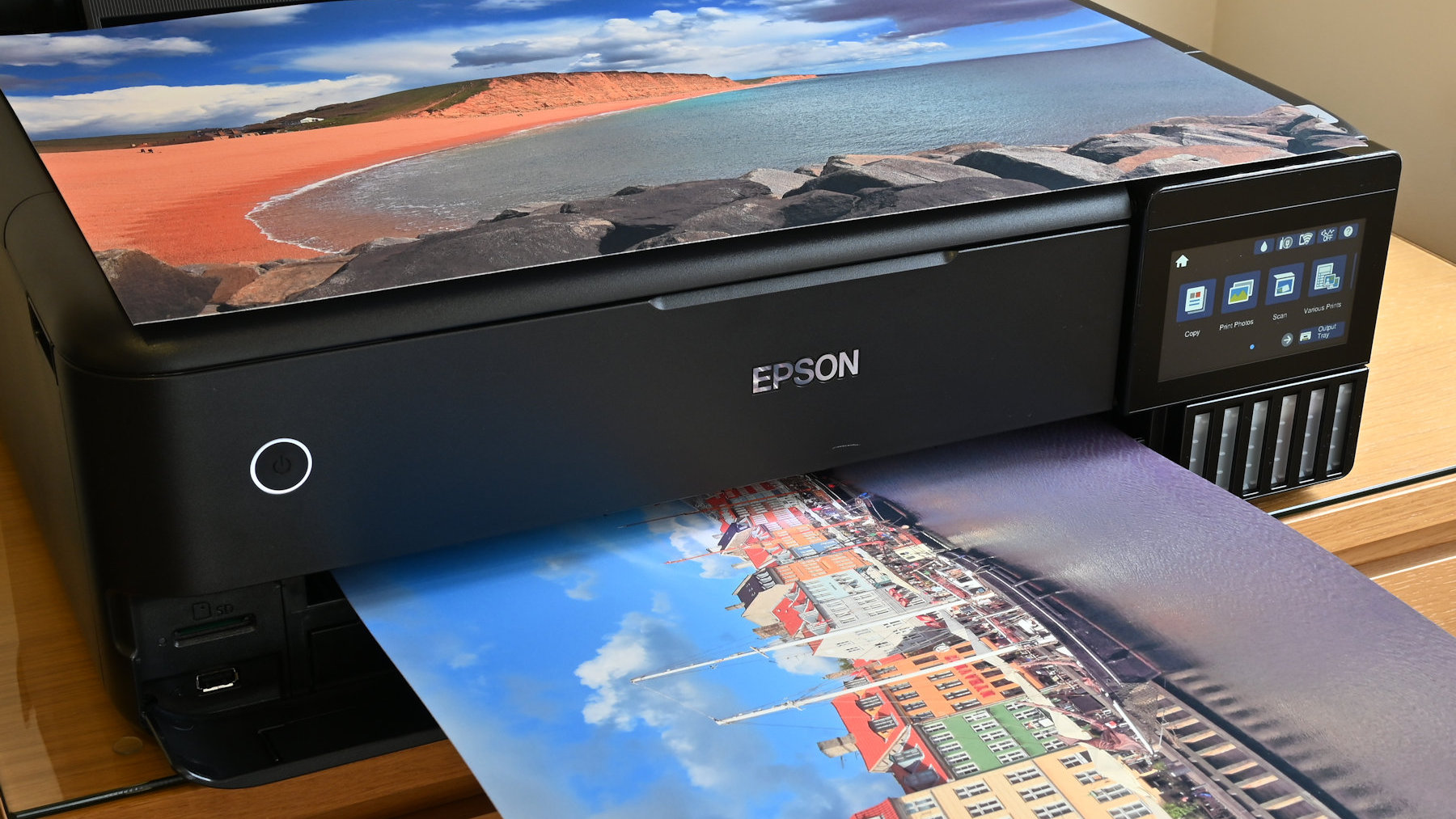
Specifications
Reasons to buy
Reasons to avoid
Given how much ink a single A3+/13x19-inch photo print requires, a printer with refillable tanks is particularly ideal. This Epson fits the bill nicely, running on the same ink line-up and replacement bottles as the A4/8.5-inch ET-8500. As such, you can expect around 2,300 6x4-inch photo prints or 6,700/6,200 mono/color pages from a full set of bottles. Naturally, the printer comes into its own for large-format photo printing, which is pretty speedy at about 2 minutes for a borderless A3+/13x19-inch color print. As well as scanning and copying, the printer also supports direct printing from SD, SDHC and SDXC memory cards and is PictBridge compliant. Standalone printing and copying is enhanced by a 4.3-inch color touchscreen.

8: Epson WorkForce WF-110W
Specifications
Reasons to buy
Reasons to avoid
This smart little mobile document printer is very self-contained, able to run from its own rechargeable battery pack, as well as from the mains. It features USB, Wi-Fi and Wi-Fi Direct connectivity. The net result is that you can create prints anywhere and everywhere, whether at a client’s premises or off on vacation. It’s nicely put together and print quality for mono and color documents is very convincing. Using pigment-based inks for its mono and tri-color cartridges, however, photo output on glossy paper is relatively lackluster. Portability comes at the price of fairly slow print speeds on battery power and expensive running costs based on relatively low-capacity ink cartridges, but that’s entirely understandable.
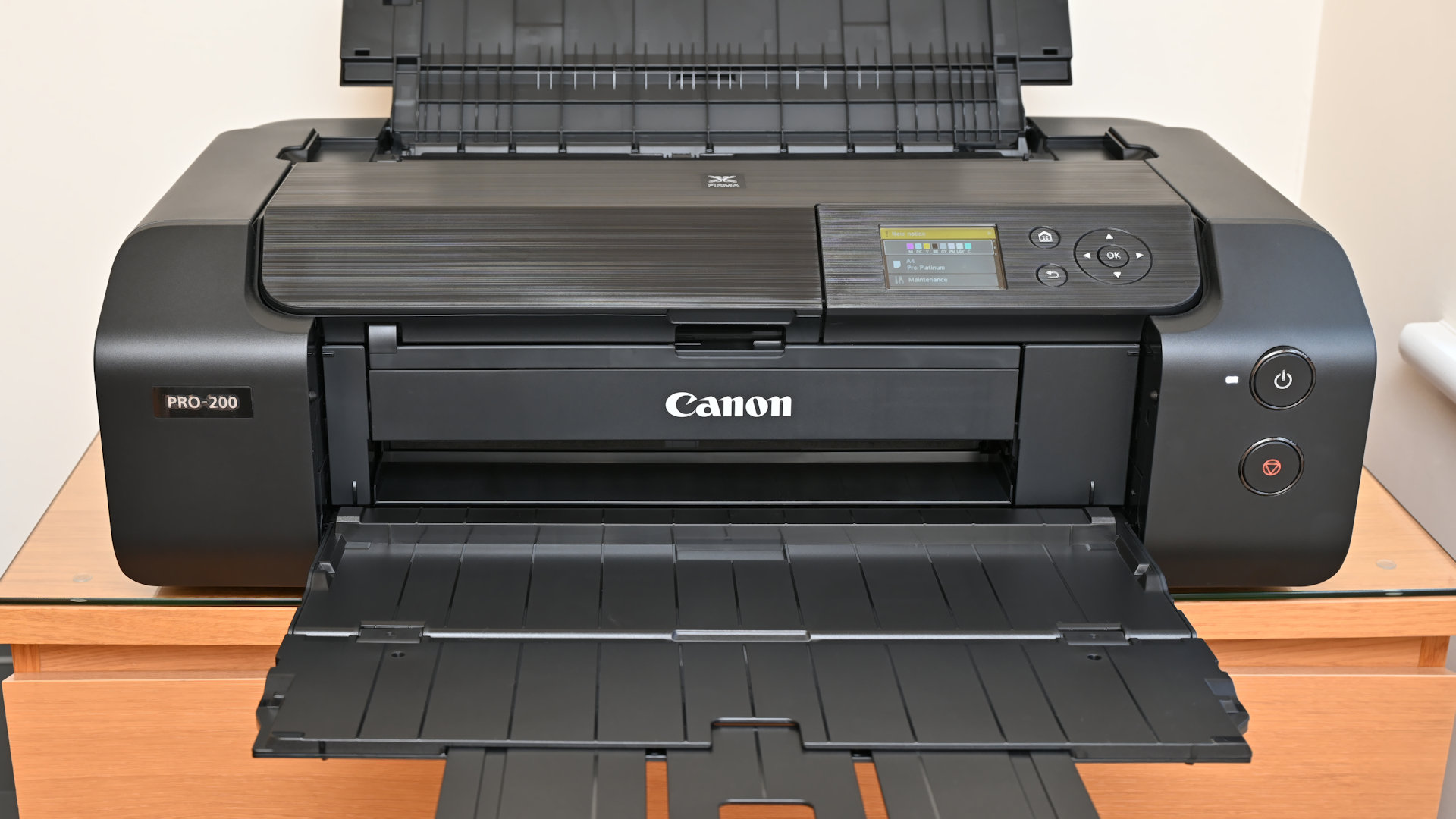
9: Canon PIXMA PRO-200
Specifications
Reasons to buy
Reasons to avoid
Running on no less than eight dye-based inks, this A3+/13-inch large-format printer rules the roost for creating finest-quality photo prints on glossy and luster paper. Excellent fidelity and tonal range are assured for both color and black & white photo images, thanks to the inclusion of black, grey and light grey cartridges in the line-up. Indeed, the inks have been reformulated, compared with Canon’s older PRO-100 series printers, to improve the gamut (or color space) while the upgraded OIG System (Optimum Image Generating System) works out the best combination of inks to use for every color and tone, on the fly, with great speed and precision. A 3-inch color LCD screen and dual paper input feeds enhance handling, as well as enabling panoramic printing on cut sheets of up to 39 inches in length.
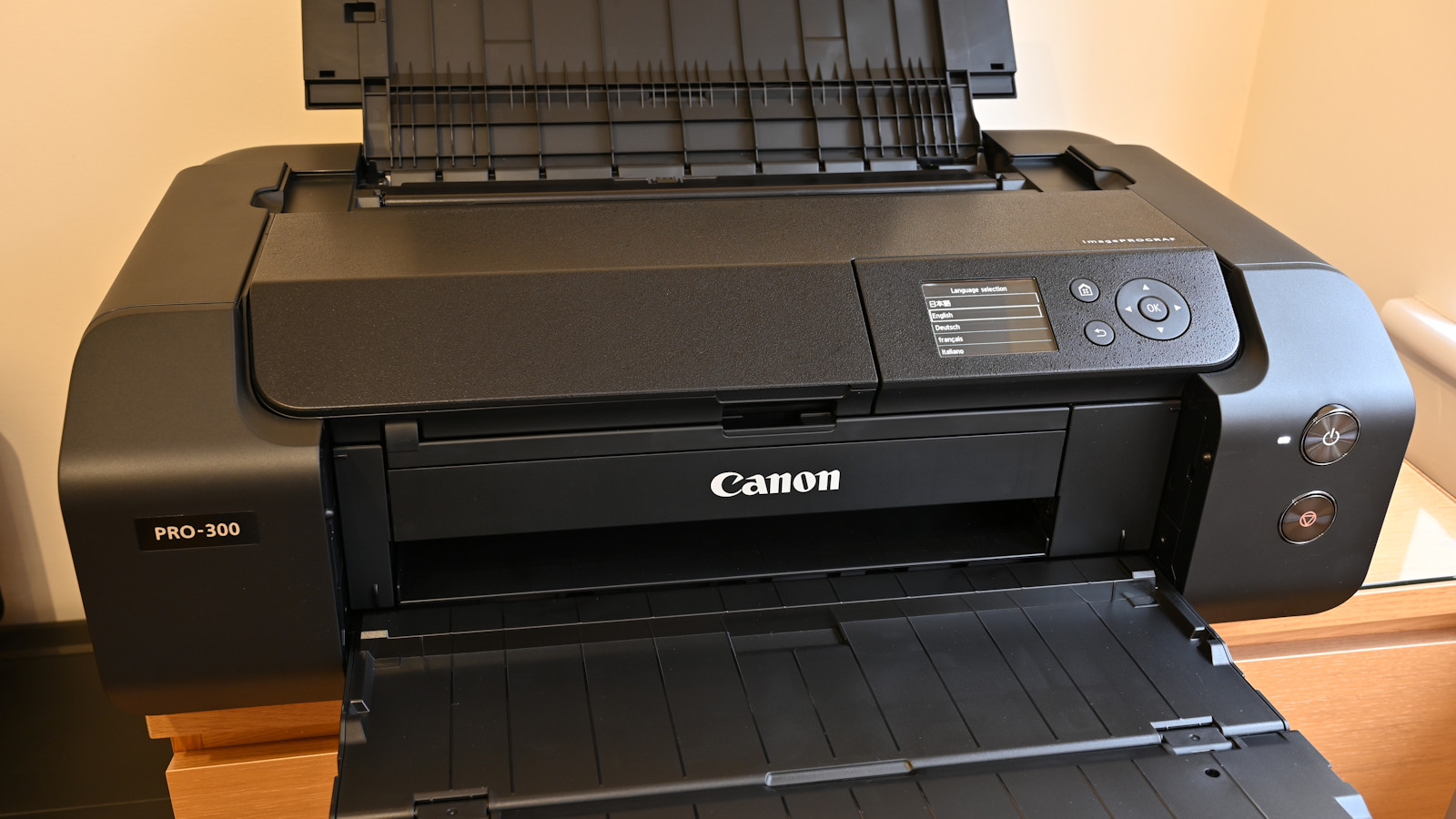
10: Canon imagePROGRAF PRO-300
Specifications
Reasons to buy
Reasons to avoid
Although it looks almost identical to Canon’s PIXMA PRO-200 A3+/13-inch printer, this one earns Canon’s range-topping imagePROGRAF stripes, with a 10-ink pigment-based ink system favored by the most demanding professional photographers. While a Chroma Optimizer cartridge helps to deliver smoother output on glossy and luster papers, compared with most pigment photo printers, the PRO-300 really comes into its own on matte and fine art photographic media. Indeed, a huge range of Canon and third-party fine art papers are directly supported and, unlike previous PIXMA PRO-10 series pigment-based models, borderless printing is available on matte media. It’s not completely risk free, as Canon doesn’t guarantee that ink won’t leach into the edges. In our tests with high-quality media, however, we’ve never had a problem. Canon’s free supporting apps are particularly powerful and print quality for both color and monochrome photographic images is simply spectacular.
Frequently asked questions about inkjet printers
Dye or pigment?
Pigment-based inks have larger molecules and are more robust. For document printing on plain paper, they’re more smudge-resistant so are less likely to be ruined by a ring of moisture from a water bottle, or from the use of highlighter pens. Pigment-base inks are also better for premium photo printing on matte photo paper and fine-art media. The flipside is that dye-based inks are better for photo printing on glossy paper, as the smaller molecules enable the ink to be fully absorbed beneath the protective glossy top layer of the paper.
How many inks?
Traditionally, CMYK (cyan, magenta, yellow and black) inks are featured in printers, as this enables effective mono and color document printing. Dual photo/document printers sometimes feature both dye-based and pigment-based black inks. The dye-based black ink enables greater depth and contrast than relying on ‘composite black’, created from mixing cyan, magenta and yellow together. Up-market photo printers tend to feature additional colors of ink, often light cyan and light magenta, for an extended gamut (or color space), and top-notch ones usually feature additional gray cartridges to extend the tonal range and drama for black & white photo prints.
Do I need a scanner facility?
Just as you need to print documents and images from your computer, you might also need to digitize or copy existing pages. The vast majority of inkjet printers these days come complete with a built-in scanner, which can add greatly to their all-round versatility. Many also feature an ADF (Auto Document Feeder) for automatic the scanning or copying of multi-page documents, saving you the chore of feeding pages in one by one. The best of breed sometimes include a scanner with ADF that can scan both sides of double-sided documents simultaneously, in one pass, effectively doubling the speed.
Cartridges or ink tanks?
Ink tanks beat cartridges for running costs and convenience. Conventional cartridge-based inkjet printers are generally sold with ‘setup cartridges’ that last next to no time, and a full set of regular replacement cartridges often costs as much or even more than the printer itself, so it’s easy to see where manufacturers make their money. And as for the lack of convenience, you can almost count on cartridges running out just when you need them most, which can be a big problem if you don’t have spares to hand. All in all, cartridges can be a pain and a financial drain for anything other than occasional printing.
Are ink tank printers messy to refill?
You might worry that refilling ink tanks with bottles might be a messy business. That often used to be the case but times have changed. Nowadays, ink bottles generally have individually keyed tops, so each one only fits in the correct tank. What’s more, they’re gravity fed so there’s no squeezing involved, and ink is only released via an internal valve once the bottle is safely positioned in the receptacle at the top of the tank. The valve will also shut off automatically once the tank is full. You can pretty much guarantee there’s no mess involved.
Do I need to use genuine cartridges?
Independently manufactured ink cartridges often cost a small fraction of the price of the genuine articles. The same goes for photo paper. However, with very cheap cartridges, there’s a risk that the ink might have impurities that can block the ultra-small nozzles of the print head, which can be a major problem. For photo printing, you also risk poor color fidelity and a massive reduction in the longevity of the print. For the sake of print quality, reliability and long-lasting results, you’re best off sticking with genuine supplies or at least opting for independent alternatives that aren’t overly cheap and have a good reputation.
How we test printers
Printers come in many shapes and sizes, from pocket photo printers to large-format professional models. We check the suitability for wide-ranging tasks from printing office documents to high-end photographic output and, consequently, the type and quantity of dye/pigment inks. Additional features can include a built-in scanner, a standalone control panel, a touchscreen interface, Wi-Fi connectivity, direct fax functions, and a card reader slot.
Our test procedure begins with installing the latest software drivers and running nozzle check and print head alignment routines. We then create test prints from mono documents, mixed text and graphics color documents, and a wide range of digital photos that include landscapes, portraits, and black & white images.
We use the various available quality modes, including optional image enhancement features. We also create prints from our own specially created test chart, to test the printer's accuracy in terms of color reproduction, tonal range, retention of detail in bright highlights and dark shadows, and the ability to deliver smooth gradations in subtle color variations. The printer manufacturer’s own-brand inks and papers are used throughout the entire testing procedure.
For output speed, we record the time taken to produce various sizes of prints at different quality settings. Ink costs are calculated on typical page yield against average prices for the manufacturer’s own-brand cartridges or bottles.
To learn more about how Digital Camera World tests products for reviews and buying guides please visit our how we test and review page.
Get the Digital Camera World Newsletter
The best camera deals, reviews, product advice, and unmissable photography news, direct to your inbox!
Matthew Richards is a photographer and journalist who has spent years using and reviewing all manner of photo gear. He is Digital Camera World's principal lens reviewer – and has tested more primes and zooms than most people have had hot dinners!
His expertise with equipment doesn’t end there, though. He is also an encyclopedia when it comes to all manner of cameras, camera holsters and bags, flashguns, tripods and heads, printers, papers and inks, and just about anything imaging-related.
In an earlier life he was a broadcast engineer at the BBC, as well as a former editor of PC Guide.

